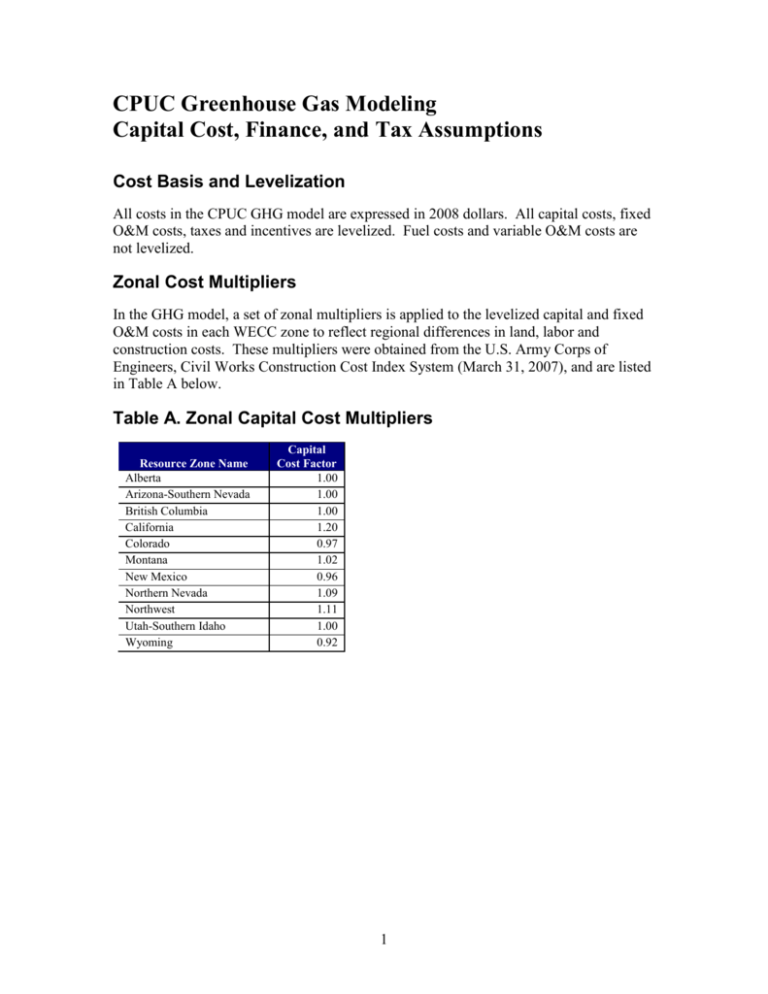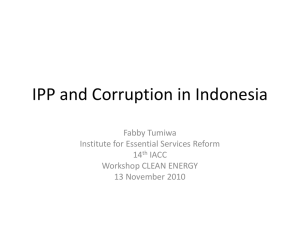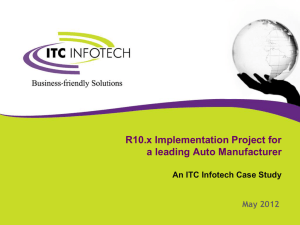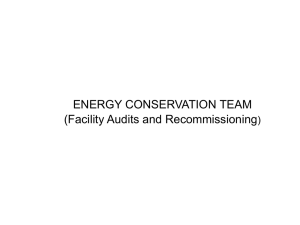30 Financing Assumptions
advertisement

CPUC Greenhouse Gas Modeling Capital Cost, Finance, and Tax Assumptions Cost Basis and Levelization All costs in the CPUC GHG model are expressed in 2008 dollars. All capital costs, fixed O&M costs, taxes and incentives are levelized. Fuel costs and variable O&M costs are not levelized. Zonal Cost Multipliers In the GHG model, a set of zonal multipliers is applied to the levelized capital and fixed O&M costs in each WECC zone to reflect regional differences in land, labor and construction costs. These multipliers were obtained from the U.S. Army Corps of Engineers, Civil Works Construction Cost Index System (March 31, 2007), and are listed in Table A below. Table A. Zonal Capital Cost Multipliers Resource Zone Name Alberta Arizona-Southern Nevada British Columbia California Colorado Montana New Mexico Northern Nevada Northwest Utah-Southern Idaho Wyoming Capital Cost Factor 1.00 1.00 1.00 1.20 0.97 1.02 0.96 1.09 1.11 1.00 0.92 1 Capital Cost Escalation In scalation factors were applied to capital costs to adjust for historic and anticipated increases in costs from 2005-2008. For all technology types except wind and solar thermal, the capital cost escalators are 25% in both 2005 and 2006, and 2.5% in 2007. For solar thermal, the escalators are 2.5% in 2005 and 2007, and 5% in 2006. For wind, the escalators are 15% in 2005 and 2006, and 2.5% in 2007.1 From 2009 to 2020, inflation is assumed to continue at 2.5% per year; the 2020 cost is then deflated at 2.5% to arrive at the cost in 2008 dollars. Asset Ownership and Financing Assumptions The GHG calculator enables users to select their own financing assumptions. Users may choose IOU, municipal utility, or IPP ownership, and may also directly select the percentage of debt and equity in the capital structure, and the cost of debt and equity capital. In the GHG model base case, the finance costs for new generation assets are based on IPP financing. There are several reasons why this is an appropriate base case assumption. Certain technologies have investment tax credit incentives available only to private sector developers, which in these cases makes IPP ownership a lower cost option. Assuming utilities will procure assets through a competitive bid process, an IPP plant may have more a aggressive financing structure and plant configuration, resulting in a lower bid price than a utility-build option. Lastly, due to utility ownership restrictions, IPP ownership may be more consistent with how resources are likely to be constructed in California, and provides a comparable basis on which to analyze resources contracted by both investor-owned and publicly-owned utilities. The ownership assumption determines the capital reimbursement term, cost of capital, and tax benefits for each project. The GHG calculator determines the all-in cost of each type of generation based on the project’s required revenue level. The required revenue amount is determined such that the owner will receive its target after-tax equity return after all tax benefits have been applied. This means that the full amount of any tax benefit is passed on to ratepayers, either through the revenue requirement in the utilityowned case, or through the contract price in an IPP-owned case. 1 The difference between the capital escalation factors for different technologies is the time basis for the cost estimate used by E3. For most technologies, capital costs were adopted from the EIA’s 2007 Annual Energy Outlook, which were based on 2005 costs. For wind and solar thermal, more recent cost estimates were used that already incorporated some cost escalation. The detailed assumptions are provided in the reports on costs and resources for each individual generation technology used in the GHG model. 2 Return Of and On Invested Capital When utility ownership is selected, a book life and project life of 30 years is assumed for all resource types. Book depreciation is used to calculate the return of invested capital based on this 30-year term. Invested capital includes both capital costs and an allowance for funds used during construction (AFUDC), also known as interest during construction (IDC) in the IPP case. The current version of the GHG calculator uses a multiplier to approximate AFUDC; the next version will calculate AFUDC using the draw schedule and construction period assumptions from the CEC’s Cost of Generation Model.2 AFUDC is accrued at the utility pre-tax WACC rate. In order to capture the front-endloaded revenue requirements profile, the annual return of and on capital is levelized at the utility WACC over a 30-year period. This levelized cost, divided by the plant capacity, creates the $/kW charge for capital. We note that currently, the levelization is performed using a pre-tax WACC. This will be changed in the next model iteration to be post-tax WACC. When municipal utility ownership is selected, assumptions are identical to the IOU case, except that municipal utility financing is assumed to be 100% debt and at a lower interest rate than available to IOUs. Levelization is also performed using the municipal utility WACC. Because municipal utilities do not pay income taxes, their pre- and post-tax WACC rates are the same. When IPP ownership is selected, the return of and on capital is treated in much the same way, except that a project and book life of 20 years is assumed for the IPP ownership case. This assumption was made because it is likely that the maximum utility contract length would be 20 years, either through a 20-year contract or renewal of a 10-year contract. In this way, the term of the underlying debt can be matched to the return of capital in the revenue stream. The IPP pre-tax WACC generates the IPP IDC amount using the same draw schedule as in the utility case. The return of and on capital is similarly levelized, but over a 20-year period using the IPP WACC, then divided by the plant capacity to create the $/kW charge for capital. The specific IPP finance assumptions used in the base case are listed in Table B below, along with the IOU and municipal utility assumptions. Note that the finance assumptions are the expected average values throughout the project term, commencing in 2020. Note also that the IPP finance assumptions are not reflective of an IPP selling its entire plant output into the market on a merchant basis, but instead assume all output is contracted under a high credit-quality utility offtake contract. The IPP debt rate assumption is 9%. This assumption incorporates additional project risk over the utility corporate debt rate assumption of 7%. The IPP equity return assumption of 17% was taken from the California State Board of Equalization’s March 2007 Capitalization Rate Study. The 70:30 D:E capitalization is an expected achieved financial structure, assuming a high credit quality PPA offtake contract. These inputs result in an IPP pre-tax WACC of 11.4%, compared to the utility pre-tax WACC assumption of 9.37%. CEC, “Comparative Costs of California Central Station Electricity Generation Technologies,” Draft Staff Report, CEC-200-2007-011-SD, June 7, 2007 2 3 An argument could also be made to set the utility and IPP pre-tax WACCs equal, assuming that the utility all-in project cost would be an appropriate cost benchmark for a successful IPP bid. Under this scenario, and with the IOU assumptions per Table B below, the IPP after-tax equity return would be approximately 14.6%. This return assumes that the tax benefit associated with additional leverage accrues to the IPP equity owner. Table B. Financing assumptions General Inflation Switch for IPP or Utility Owned (1=IOU, 2=Muni, 3=IPP) 2.50% 3 Active Tax Rate Financing Life (years) Cost of Equity Equity Share in Capital Structure Cost of Debt Calculated IPP ROE at IOU WACC - before DTS benefit Pre-tax WACC 40% 20 17.00% 30% 9.00% IOU 40% 30 11.74% 50% 7.00% 11.40% 9.37% Muni 0% 30 0.00% 0% 6.50% 6.5% IPP 40% 20 17.00% 30% 9.00% 10.2% 11.4% Taxes and Tax Incentives For all types of ownership, cash taxes (rather than book taxes) determine the income tax burden. For the year 2020, the model assumes a 35% federal tax rate and an 8% state tax rate, resulting in a 40% marginal tax rate. Taxable income was calculated using the technology-appropriate tax depreciation schedules and full tax benefit of interest. The model currently assumes state accelerated depreciation tax benefits; this assumption will be changed in a future version to reflect no state-level accelerated depreciation, as is the current case in California. Taxes were grossed up such that the owner achieved its target after-tax return on equity, following which any production or investment tax credits were applied. Taxes were levelized over the appropriate ownership term, then divided by the plant capacity to achieve a levelized $/kW charge. Property taxes were assumed to be 1% of the total project capital costs, and property tax amounts were also levelized. Tax and Policy Incentives Many of the generating technologies in the GHG calculator are eligible for a variety of tax breaks and other incentives from either the federal or state government. Currently available federal government tax benefits include investment tax credits, production tax credit (PTC), and accelerated depreciation, and California state-level incentives include property-tax incentives and Supplemental Energy Payments. The model assumes that the state-level SEP and property tax incentives would no longer be available in 2020, nor would federal incentives that with cumulative capacity limitations. Other federal tax benefits are assumed to be permanently available at 2008 levels. Therefore, the current investment tax credit (ITC) is assumed to apply to geothermal and solar thermal assets in 2020, and the current production tax credit (PTC) is assumed to apply to biogas & biomass, large and small hydro, and wind projects. Table C below details current tax policy. 4 The calculator assumes that the investment tax credit will continue to be available only if a project is under IPP ownership, and that accelerated depreciation and PTC benefits would be available to both IOUs and IPPs. Because municipal utilities do not pay taxes, the cost of their projects are not impacted by tax benefits. The ITC is applied to eligible project costs, therefore the calculator provides an input that allows users to reduce total capital costs by a multiplier to obtain the eligible project costs. In the base case, the model assumed that 75% of total project costs are ITCeligible costs, and that the entire ITC was available in the first year. The term of the PTC is 10 years. The first year PTC amount was escalated by inflation over the 10-year term, then present-valued to 2008. Both ITC and PTC were also levelized. Table C. Tax Incentives Incentives Technology Coal IGCC Natural Gas CCCT Federal 20% ITC (limited to first 4 GW of new IGCC capacity);1 Loan guarantees of up to 80% for qualifying technologies. 2 20% ITC (limited to first 4 GW of new IGCC capacity); 1 Loan guarantees of up to 80%.2 If advanced coal technology: 15% ITC (limited to first 3 GW of new capacity); 1 None. Natural Gas CT None. None. Nuclear 1.8¢/kWh PTC (nominal $) for first 8 years of operation if inservice by 2020 (limited to first 6 GW of new capacity); 3 Loan guarantees of up to 80%.2 If closed loop biomass: 1.9¢/kWh PTC (inflation-adjusted 2007$) for first 10 years of if in service by 2008, If landfill gas, municipal solid waste or open loop biomass: 1.0¢/kWh PTC for first 10 years of if in service by 2008. 4 None. Coal IGCC w/ CCS Coal ST Biogas & Biomass 5 CA State None. None. None. None. SEP eligible (if meets certain requirements)7 Incentives Technology Geothermal Large Hydro Small Hydro Solar Thermal Wind Federal 1.9¢/kWh PTC (inflation-adjusted 2007$) for first 10 years of operation if in-service by 20084 OR 10% permanent ITC5; Accelerated depreciation (5 year)6 For incremental addition at existing generator, or generation built at existing non-hydroelectric dam: 1.0¢/kWh PTC (inflationadjusted 2007$) for first 10 years if in-service by 20084 1.0¢/kWh PTC (inflation-adjusted 2007$) for first 10 years if inservice by 20084 30% ITC if in-service by 2008, 10% permanent ITC otherwise5; accelerated depreciation (5 year)6 CA State SEP eligible7 1.9¢/kWh PTC (inflation-adjusted 2007$) for first 10 years of operation if in-service by 20084; Accelerated depreciation (5 year)6 SEP eligible7 PTC= Production Tax Credit; SGIP = Self Generation Incentive Program; MSW = Municipal Solid Waste None. SEP eligible if ≤30 MW and no increased water diversion7 100% property tax exemption8; SEP eligible7 ITC = Investment Tax Credit; RPS = Renewable Portfolio Standard SEP = Supplemental Energy Payments Sample Results Table D below describes the model results for a selection of technologies under the various ownership assumptions. As can be seen below, with assumptions per Table B, municipal utility ownership results in the lowest costs in all cases. IOU costs are next lowest in all cases except IPP solar thermal, due to the presence of the 30% ITC. Table D. Selected Results All-in Levelized Busbar Cost ($/MWh) IOU Municipal Utility IPP Coal IGCC 79.07 Coal ST 71.27 Gas CCCT 75.59 Geother mal 85.14 97.94 57.15 52.27 68.36 70.54 133.46 88.76 79.73 78.78 86.77 Biomass 121.79 Sources and Footnotes 6 Hydro Large 96.59 Nuclear 116.63 Solar Thermal 152.56 Wind 72.49 67.00 82.24 118.07 63.39 111.08 131.80 124.92 82.76 Federal Policy Incentives: 1 Investment Tax Credit (ITC) for IGCC and Advanced Coal Technologies: From the Energy Policy Act of 2005, Title XIII, Section 48A (Qualifying Advanced Coal Project Credit), and Section 48B (Qualifying Gassification Project Credit). ITC is limited to a national total of 4.125 GW for new IGCC capacity and to 3.375 GW for other advanced coal-based generation technologies. Funding is also limited to a total of $800 million in total ITCs for gasification, and $500 million in total ITCs for advanced coal technologies. Technologies to retrofit or re-power existing coal plants may also qualify as an advanced coal technology, provided that the fuel input is at least 75% coal. To be designated as an advanced coal project, new non-IGCC plants must have: (a) heat rate of 8530 Btu/kWh or better [subject to some adjustments] (b) SO2 removal of 99% or higher, (c) NOx Emissions of 0.07 lbs/MMBTU, (d) Particulate emission of 0.015 lbs/MMBTU, and (d) Mercury removal of 90% or higher. IGCC technologies used for generators using petroleum residue or biomass may also qualify for the gasification ITC. Application must be submitted to DOE by 2006 and online date must be within 7 years; ITC value is reduced proportionally for plants also receiving incentive loan guarantees. 2 Federal Loan Guarantees for Innovative Technologies: Coal facilities with IGCC or carbon sequestration, and certain advanced nuclear technologies may qualify for federal loan guarantees of no more than 80% of project cost under then Energy Policy Act of 2005, Title XVII, Section 1702-1704. IGCC plants must meet certain performance and emissions requirements to qualify, and have one of a number of defined innovative components, including a CO2-capture ready design. 3 Production Tax Credit (PTC) for Nuclear: From the Energy Policy Act of 2005, Title XIII, Section 45J (Credit for Production from Advanced Nuclear Facilities). “Advanced Nuclear” is deemed to be any nuclear reactor design approved by the Nuclear Regulatory Commission after 1993. The credit is limited to the first 6 GW of new nuclear capacity in the U.S., and is limited to $125 million per GW annually. If more than 6 GW are under construction before January 1, 2014, the production will be shared among the new reactors on a proportional basis (e.g., if 9 GW of new capacity are under construction by that date, the PTC will be set to 1.2¢/kWh (= 1.8¢/kWh * 6 GW / 9 GW). [Allocation described in EIA, “Assumptions to Annual Energy Outlook 2007”, p. 88.]. 4 Investment Tax Credit (ITC) for Solar, Geothermal: Also known as the business energy tax credit, from United States Code (USC) Title 26 (Internal Revenue Code), § 48. Expanded by the Energy Policy Act of 2005, House Resolution (H.R.) 6, and extended to cover all installations before January 1, 2009 by the Tax Relief and Healthcare Act of 2006 (H.R. 6111), Section 207. Energy Policy Act of 1992 created a permanent 10% ITC for solar, geothermal, and qualifying biomass generation. Energy Policy Act of 2005 temporarily raised this ITC to 30% for solar technologies installed between 2006 and 2008. Credit is reduced if generation is subsidized by other state or federal level financing incentives. 7 5 Production Tax Credit (PTC) for Qualifying Biomass, Geothermal, Wind, and Hydro: Officially the Renewable Electricity Production Credit (REPC), from United States Code (USC) Title 26 (Internal Revenue Code), § 45. Originally enacted as part Energy Policy Act of 1992 to apply to installations of wind and qualifying biomass during or before 2001. Renewed for 2006-2007 under the Energy Policy Act of 2007, and extended to geothermal and qualifying hydro generation as well. Extended through end of 2008 under the the Tax Relief and Health Care Act of 2006 (H.R. 6111). “Closed-loop biomass” is defined as “any organic material from a plant which is planted exclusively for purposes of being used at a qualified facility to produce electricity.” If the reference energy price exceeds 8 cents/kWh in the year, the PTC is reduced proportionally to as low as 3 cents/kWh. 6 Accelerated Depreciation: USC, Chapter 26, § 168 (2005). Under the Modified Accelerated Cost-Recovery System (MACRS), business can recover their investments more quickly through accelerated depreciation on solar, geothermal, wind and photovoltaic generation assets, reducing their corporate income tax. These renewable technologies are classified as “5-year property”. For more information, see IRS Publication 946, IRS Form 4562: Depreciation and Amortization, and Instructions for Form 4562. California Policy Incentives: 7 Supplemental Energy Payments (SEP): Facilities must be are new or repowered on or after January 1, 2002, and may receive payments for up to 10 years. RPS eligible generators that win contracts with IOUs in California can apply to the CEC to receive SEPs to cover the difference between the MPR (market price referent) and the accepted bid price, subject to funding availability. 8 CA Property Tax Exemption for Solar Systems: From CA Revenue & Tax Code § 73. AB1099 in 2005 extended this section to apply to all systems installed before January 1, 2009. Further description of Federal and state policy incentives: North Carolina Solar Center & Interstate Renewable Energy Council, Database of State Incentives for Renewables & Efficiency (February 2007 Update). http://www.dsireusa.org/Index.cfm?EE=0&RE=1 U.S. Energy Information Administration, “Assumptions to the Annual Energy Outlook 2007,” Report # DOE/EIA-0554(2007), http://www.eia.doe.gov/oiaf/aeo/assumption/index.html. 8








